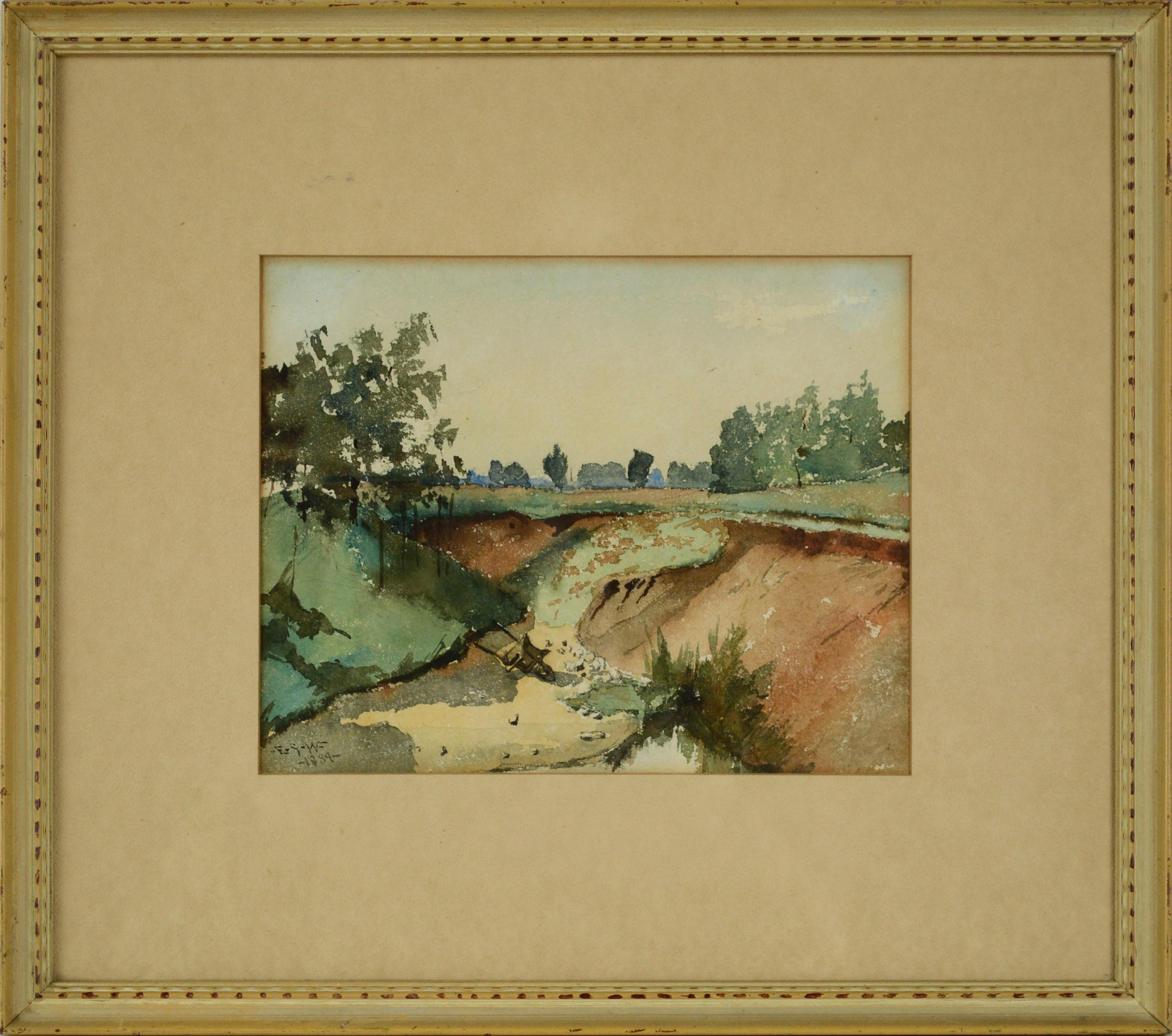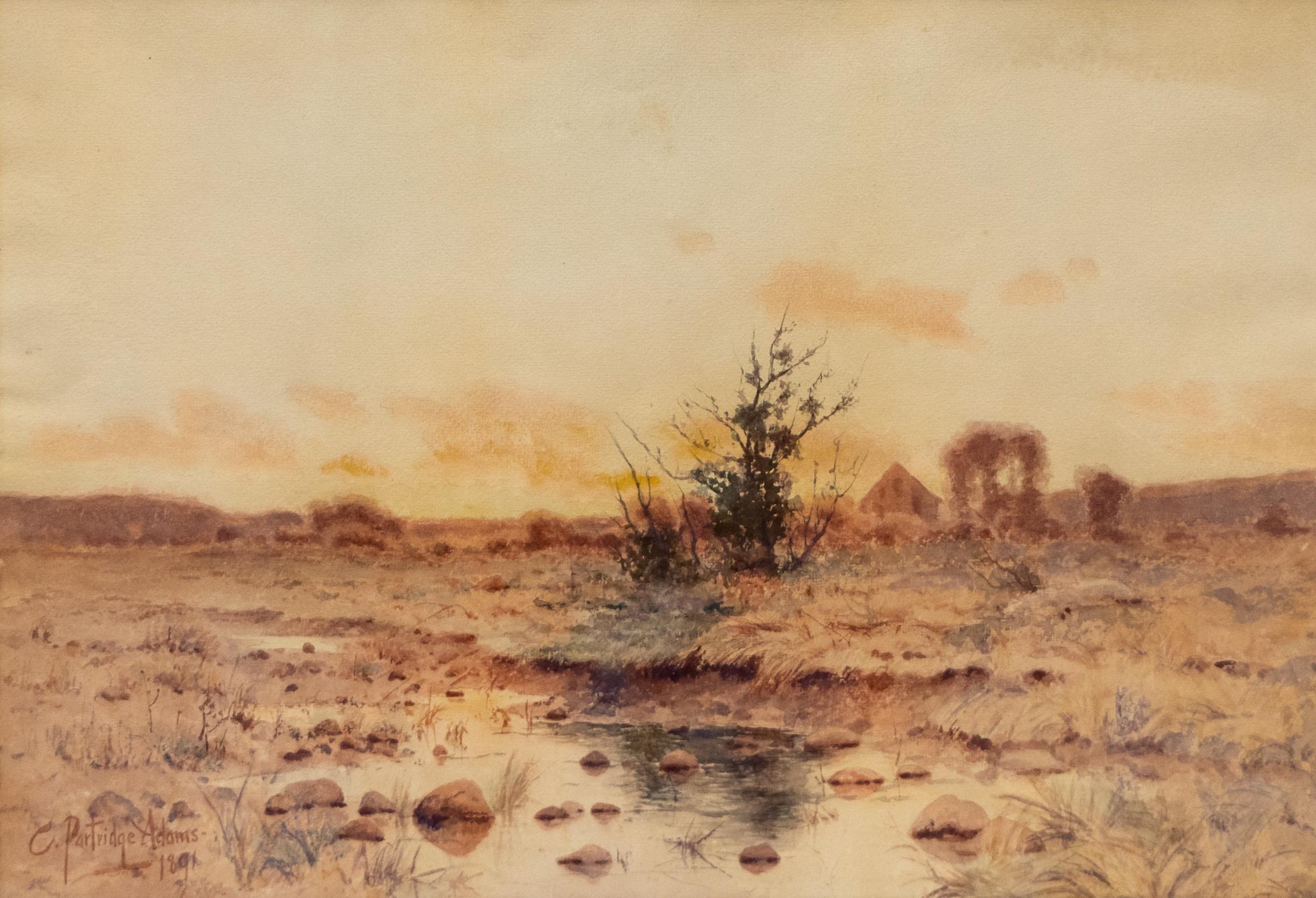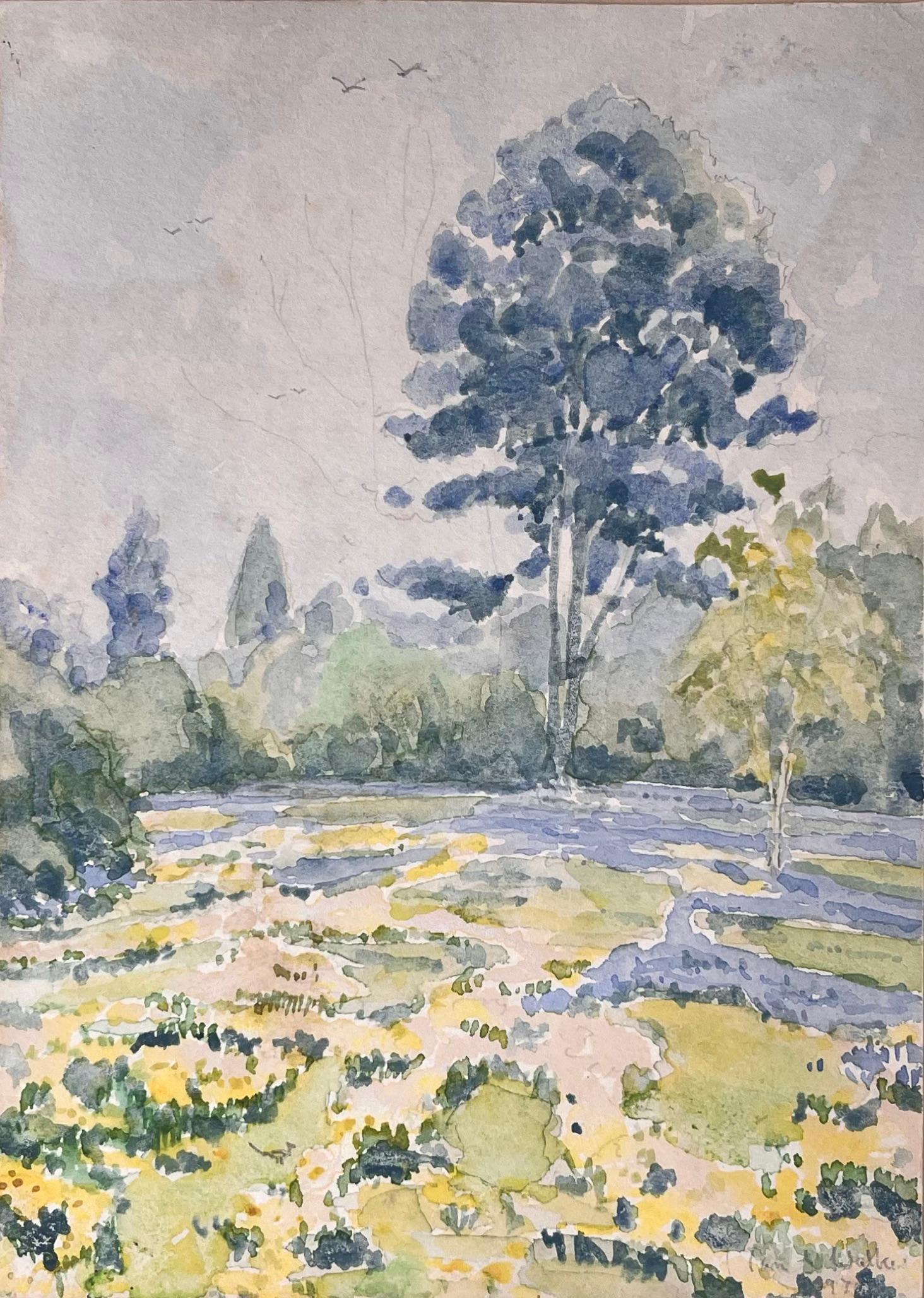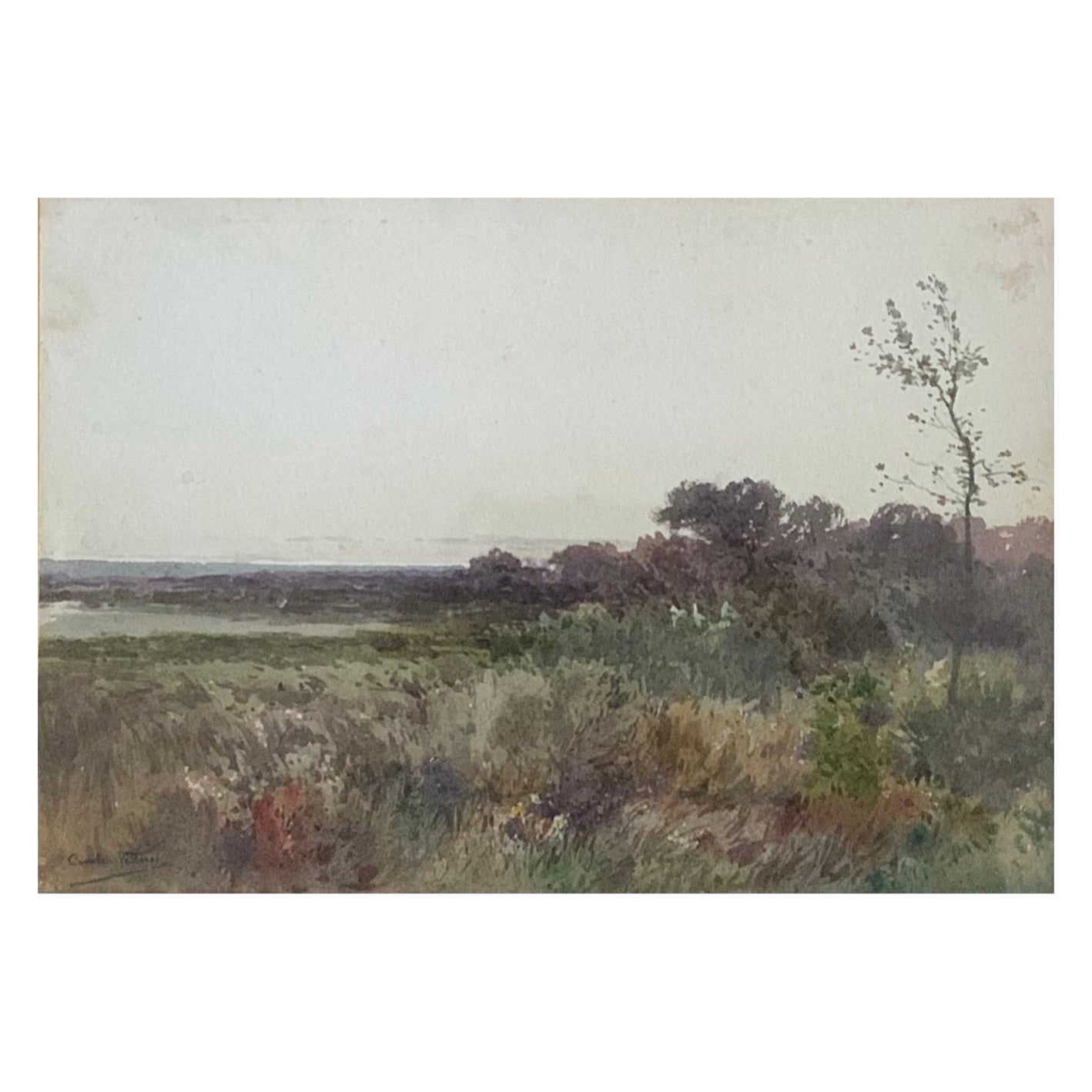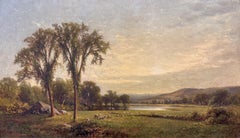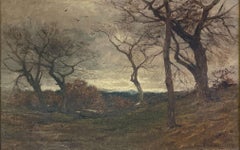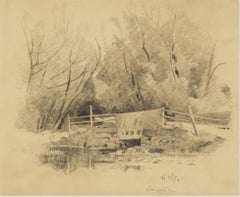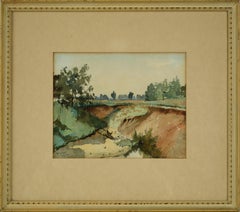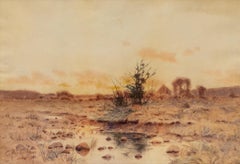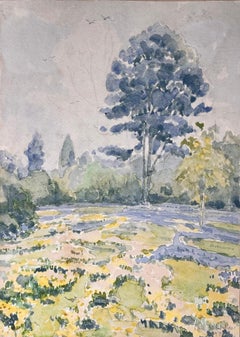Items Similar to "The Meadow" Charlotte Buell Coman, Tonalist Watercolor American Landscape
Want more images or videos?
Request additional images or videos from the seller
1 of 7
Charlotte Buell Coman"The Meadow" Charlotte Buell Coman, Tonalist Watercolor American LandscapeLate 19th Century
Late 19th Century
$2,800
£2,126.11
€2,431.36
CA$3,912.01
A$4,351
CHF 2,271.96
MX$52,947.10
NOK 29,016.39
SEK 27,212.25
DKK 18,146.18
Shipping
Retrieving quote...The 1stDibs Promise:
Authenticity Guarantee,
Money-Back Guarantee,
24-Hour Cancellation
About the Item
Charlotte Buell Coman
The Meadow
Signed lower left; titled on the reverse
Watercolor on paper
6 1/4 x 7 inches
Charlotte Buell Coman, a landscape painter from Waterville, New York, came to St. Augustine in 1890. Coman began her artistic career under the tutelage of Hudson River School artist James Brevoort. Brevoort may have introduced her to the French Barbizon style. She later studied in Paris and Holland with Emile Vernier and Harry Thompson.
She was included in many exhibitions during her lifetime, including in the New York Society of Painters Annual Exhibition as well as the California Exposition of Landscape Painters. In addition, she received many honors, including a medal at the Midwinter Exposition in San Francisco in 1894, the Shaw Memorial Prize at the exhibition of the Society of American Artist in 1905, the Second Prize at the exhibition of the Society of Washington Artists in 1906, and the Burgess Prize from the New York Women’s Art Club in 1907, amongst others.
A member of the New York Watercolor Club, the National Academy of Design, and the National Association of Women Painters and Sculptors, Coman is represented in a number of permanent collections including the Metropolitan Museum in New York, and the National Gallery of Art in Washington D.C.
- Creator:Charlotte Buell Coman (1833 - 1924)
- Creation Year:Late 19th Century
- Dimensions:Height: 6.25 in (15.88 cm)Width: 5 in (12.7 cm)
- More Editions & Sizes:Unique WorkPrice: $2,800
- Medium:
- Movement & Style:
- Period:
- Condition:
- Gallery Location:New York, NY
- Reference Number:1stDibs: LU1841215510572
About the Seller
5.0
Platinum Seller
Premium sellers with a 4.7+ rating and 24-hour response times
Established in 2022
1stDibs seller since 2022
115 sales on 1stDibs
Typical response time: <1 hour
- ShippingRetrieving quote...Shipping from: New York, NY
- Return Policy
Authenticity Guarantee
In the unlikely event there’s an issue with an item’s authenticity, contact us within 1 year for a full refund. DetailsMoney-Back Guarantee
If your item is not as described, is damaged in transit, or does not arrive, contact us within 7 days for a full refund. Details24-Hour Cancellation
You have a 24-hour grace period in which to reconsider your purchase, with no questions asked.Vetted Professional Sellers
Our world-class sellers must adhere to strict standards for service and quality, maintaining the integrity of our listings.Price-Match Guarantee
If you find that a seller listed the same item for a lower price elsewhere, we’ll match it.Trusted Global Delivery
Our best-in-class carrier network provides specialized shipping options worldwide, including custom delivery.More From This Seller
View All"Flushing Landscape with Cows, " Charles Henry Miller, Barbizon, Rural Farm
By Charles Henry Miller
Located in New York, NY
Charles Henry Miller
Flushing Landscape with Cows, circa 1880
Signed lower left
Oil on canvas
13 x 19 inches
Charles Henry Miller was a noted artist and painter of landscapes from Long Island, New York. The American poet Bayard Taylor called him, "The artistic discoverer of the little continent of Long Island."
Miller was educated at Mount Washington Collegiate Institute, and graduated in medicine at the New York Homeopathic Institute in 1864. Before his graduation, he had occasionally painted pictures, and in 1860 he exhibited The Challenge Accepted at the National Academy of Design, in New York City.
He lived in Queens at the summer estate, Queenslawn, originally purchased by his parents. He went abroad in 1864 and again in 1867, and was a pupil in the Bavarian Royal Academy at Munich under the instruction of Adolf Lier...
Category
1880s Barbizon School Landscape Paintings
Materials
Canvas, Oil
"Farmland Meadows" George Henry Smillie, Hudson River School, Sunset Landscape
By George Henry Smillie
Located in New York, NY
George Henry Smillie
Farmland Meadows, 1865
Signed and dated lower left
Oil on canvas
10 1/2 x 18 inches
Provenance
Private Collection, Langley, Washington
The career of George Sm...
Category
1860s Tonalist Figurative Paintings
Materials
Canvas, Oil
"Stone Wall, Autumn, " George Smillie, Tonalist Fall Landscape View
By George Henry Smillie
Located in New York, NY
George Henry Smillie (1840 - 1921)
Stone Wall, Autumn, 1879
Oil on canvas
9 1/2 x 15 inches
Signed and dated lower right
Provenance:
Skinner, Boston, September 19, 2014, Lot 389
The career of George Smillie (1840-1921) followed the arc of nineteenth-century U.S. landscape painting. Trained in the Hudson River School tradition, Smillie successfully adapted to changing U.S. tastes and growing interest in European trends. In the late 1800s, he moved to tonalist paintings full of brushwork and influenced by French Barbizon painting. By the end of his career, he had lightened his palette to produce works similar to those of the U.S. impressionists. Yet in all styles, he was never less than competent, and his tonalist work is among the best produced in the United States.
Like many nineteenth-century painters, George Smillie’s artistic training began with the study of printing. His father, James Smillie...
Category
1870s Tonalist Landscape Paintings
Materials
Canvas, Oil
"Saratoga, " John Francis Murphy, Hudson River School, Tonalism
By John Francis Murphy
Located in New York, NY
John Francis Murphy (1853 - 1921)
Saratoga, 1876
Graphite on paper
Sight 8 3/4 x 10 1/2 inches
Titled and dated to lower right
Provenance:
Babcock Galleries, New York
Spanierman Gallery, New York
In his lifetime, John Francis Murphy (1853-1921) was known as “the American Corot.” He was renowned for his small, intimate views of nature, especially barren fields and farms, bare trees, and lonely marshland. More than a century later, the power of Murphy’s landscapes has not waned. One contemporary critic wrote, “It was Murphy’s unique accomplishment to achieve an absolute realism without a loss of that mystic, indefinable quality which transfigures realism.”
John Francis Murphy was born at Oswego, NY in 1853 but his family moved to Chicago in 1868 where he worked painting theater sets. Murphy was basically a self-taught artist; his only formal training was a few weeks of instruction at the Chicago Academy of Design.
In 1875, Murphy moved from Chicago to New York, eventually rooming with the painters Dennis Bunker and Bruce Crane above a bakery shop. Murphy’s early work was typical of the Hudson River school but he soon fell under the sway of the loose brushwork and moody style of French Barbizon painting...
Category
1870s Tonalist Landscape Drawings and Watercolors
Materials
Paper, Pencil
$2,800 Sale Price
20% Off
"Near Bourron, France" Gilbert Munger, Barbizon School, Countryside Landscape
Located in New York, NY
Gilbert Munger
Near Bourron, France, circa 1886
Signed lower left
Oil on panel
13 x 18 inches
Gilbert Munger was born on April 14, 1837 in Madison, Connecticut. He showed interest ...
Category
1880s Barbizon School Figurative Paintings
Materials
Oil, Wood Panel
"Verdant Summer Landscape, " Olive Parker Black, Tonalism, Female Artist Stream
By Olive Parker Black
Located in New York, NY
Olive Parker Black (1868 - 1948)
Verdant Summer Landscape
Oil on canvas
20 x 30 inches
Signed lower left
An accomplished landscape painter, Olive Black ...
Category
Early 20th Century Tonalist Landscape Paintings
Materials
Canvas, Oil
You May Also Like
Late 19th Century California Landscape Watercolor
Located in Soquel, CA
Beautiful late 19th-century watercolor landscape in the style of Elmer Wachtel (American, 1864-1929), by an unknown 19th-century artist. This small watercolor...
Category
1880s American Impressionist Landscape Drawings and Watercolors
Materials
Paper, Watercolor
$700 Sale Price
20% Off
1890s Watercolor Landscape – Sunrise & Spring Blossoms Over Platte River
By Charles Partridge Adams
Located in Denver, CO
An original 1891 watercolor painting by noted American landscape artist Charles Partridge Adams, titled "Spring Blossoms." This serene composition captures the Platte River at sunris...
Category
1890s American Impressionist Landscape Paintings
Materials
Watercolor
Albert Stevens (fl.1872-1902) - Late 19th Century Watercolour, Summer Landscape
Located in Corsham, GB
A wonderful landscape study by the artist Albert Stevens, depicting a panoramic view of rolling hills and a distant coastline. Well presented in a double card mount and frame. Signed...
Category
19th Century Landscape Drawings and Watercolors
Materials
Watercolor
Finely Detailed British Watercolor of a Woodland Scene
Located in Cirencester, Gloucestershire
Medium: Watercolour on paper, unframed
Size: 14 inches (height) x 10 inches (width)
Signed: Yes
Condition: Sound condition, with some minor signs of foxing visible
Provenance: Privat...
Category
Mid-20th Century Impressionist Landscape Paintings
Materials
Watercolor
Combe-Velluet Watercolor Landscape France 19th Century
Located in Beuzevillette, FR
Landscape of a plain in watercolor on paper. This painting of warm colors reveals a tree-like vegetation that seems to move to the rhythm of the wind.
Created by the French paint...
Category
Antique Late 19th Century French Paintings
Materials
Paint, Paper
1900's English Impressionist Watercolor Painting Silent Cloudy Meadow
Located in Cirencester, GB
Cloudy meadow
English school, early 1900's
original watercolor painting on artists paper, unframed.
Overall paper size: 7.5x 11 inches.
From a large private collection of Eng...
Category
Early 20th Century Paintings
Materials
Other
More Ways To Browse
Thompson Antique
James Holland
19th Century French Barbizon Landscape Painting
Dutch Watercolor 19th Century
Augustine Paris
Benson Signed
Edward Walker
Landscape Painting By Collins
Oil Paintings Mississippi
Pafa Artists
Watercolor Of Harbour
Impressionist Food Painting
Mexican Boat Paintings
Notre Dame Impressionist
Paul Bell
Railroad Oil Paintings
1960s Surreal Art
Carmel Coast Art
